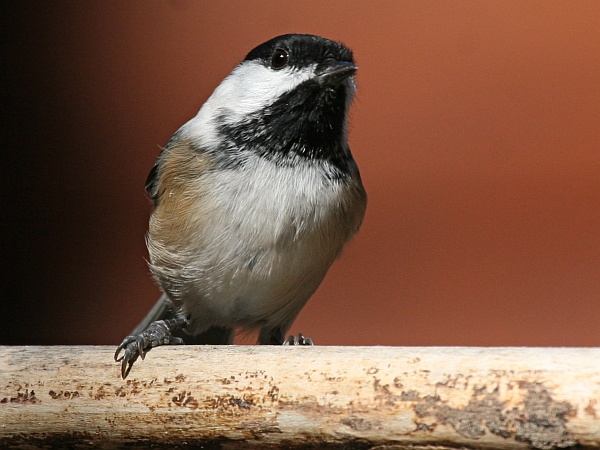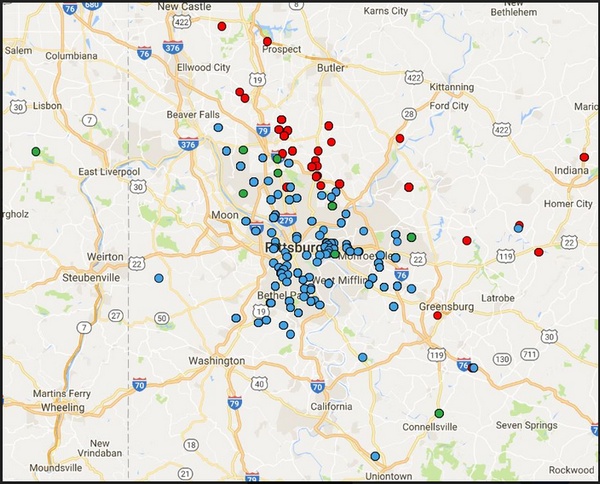
24 March 2017
A PABIRDS discussion about chickadees in North Park reached this surprising conclusion: If you think you’ve seen a black-capped chickadee in Allegheny County, think again. They’re hard to find and there are fewer every year. The reason why this is happening makes our chickadees harder to identify than your typical backyard bird.
Pittsburgh’s chickadees are puzzling because we live in the contact zone where black-capped (Poecile atricapillus) and Carolina (Poecile carolinensis) meet. When the two meet they hybridize. Females of both species prefer Carolina males for extra-pair copulation(*). The birds cross and back cross until the gene pool is really mixed up. Though they can hybridize the species remain distinct.
Black-capped and Carolina chickadees are usually identified by range — black-cappeds in the north, Carolinas in the south — but in the contact zone they’re hard to tell apart and the hybrids have traits of both. Some look like one species and sound like the other. Robert Curry and his team at Villanova University study chickadees in eastern Pennsylvania’s contact zone and have found that the only reliable way to identify them is by DNA test!
Here’s a black-capped and Carolina chickadee side by side, linked from Robert Curry’s Lab website. You can see that the black-capped is larger, more colorful, and has a relatively longer tail …

… but they don’t pose together in the field. Use these tips from Project Feederwatch for identifying Pittsburgh’s chickadees. Look and listen for more than one characteristic. If you’re not sure, label the chickadee as Carolina/Black-capped in eBird.
So why are black-capped chickadees hard to find in Allegheny County? Why are there fewer every year? Because the chickadee contact zone is moving north in step with our warming climate! (more on that next week)
I used to assume that “north of the rivers” was reliable black-capped territory but not any more. In these maps from Neighborhood Nestwatch data, Bob Mulvihill plotted four years of banding black-cappeds (red), Carolinas (blue) and hybrids (green) within 50 miles of Downtown Pittsburgh. Neighborhood Nestwatch didn’t use DNA tests; they measured the birds.

As you can see, the Carolinas and hybrids have (roughly) reached I-76 and jumped east of it in Monroeville. Look at all the green dots — hybrids! Click here for more of Bob’s chickadee maps including two zoomed in on northern Allegheny County.
Take care when you identify a chickadee in the contact zone that reaches from New Jersey to Kansas. You can’t be lazy when identifying Pittsburgh’s puzzling chickadees.
(*) p.s. extra-pair copulation: Chickadees are socially monogamous but not sexually monogamous. In the hybrid zone, all the females prefer to mess around with Carolina males.
(photo of black-capped chickadee at top by Chuck Tague. Black-capped and Carolina side-by-side photo is linked from Robert Curry’s Lab website. Map of southwestern Pennsylvania Neighborhood Nestwatch chickadees: black-capped, Carolina and hybrid-sized by Robert Mulvihill, used by permission.)
Thank you for this info. Black-capped are a fovorite…love their spunkiness. Will look intensely as the days go by. Happy spring, Kate!
Excellent narrative and graphics! Quite informative! Thanks!
I had no idea! Been staring out my window all these years thinking I was assuredly looking at black-capped chickadees. Now I’m not so sure! This is why I love reading your blog, Kate, I get smarter every day
In the last 20+ years here in Tarentum/Brackenridge I’ve only heard the Carolina Chickadee song once!
Just FWIW.
Years ago at a friend’s Christmas party I met a woman who said she was doing a degree in ornithology. I asked, Are the chickadees here black-capped or Carolinas? Well, that was her subject! The intergrade boundary may have changed since.